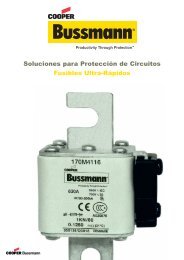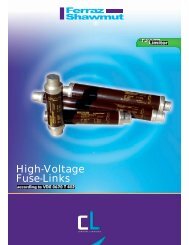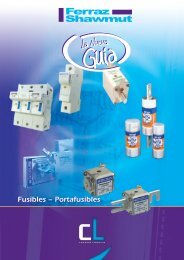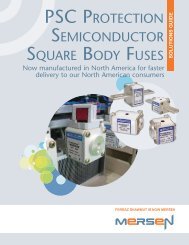Bussmann
You also want an ePaper? Increase the reach of your titles
YUMPU automatically turns print PDFs into web optimized ePapers that Google loves.
Glossary of Terms<br />
<strong>Bussmann</strong> ®<br />
Ohm’s Law<br />
The relationship between voltage, current,<br />
and resistance, expressed by the equation E<br />
= IR, where E is the voltage in volts, I is the<br />
current in amperes, and R is the resistance in<br />
ohms.<br />
One Time Fuses<br />
Generic term used to describe a Class H<br />
nonrenewable cartridge fuse, with a single<br />
element.<br />
Overcurrent<br />
A condition which exists on an electrical<br />
circuit when the normal load current is<br />
exceeded. Overcurrents take on two separate<br />
characteristics—overloads and short circuits.<br />
Overload<br />
Can be classified as an overcurrent which<br />
exceeds the normal full load current of a circuit.<br />
Also characteristic of this type of overcurrent is<br />
that it does not leave the normal current carrying<br />
path of the circuit—that is, it flows from<br />
the source, through the conductors, through<br />
the load, back through the conductors, to the<br />
source again.<br />
Peak Let-Through Current, lp<br />
The instantaneous value of peak current letthrough<br />
by a current-limiting fuse, when it<br />
operates in its current-limiting range.<br />
Renewable Fuse (600V & below)<br />
A fuse in which the element, typically a zinc<br />
link, may be replaced after the fuse has<br />
opened, and then reused. Renewable fuses<br />
are made to Class H standards.<br />
Resistive Load<br />
An electrical load which is characteristic of<br />
not having any significant inrush current.<br />
When a resistive load is energized, the current<br />
rises instantly to its steady-state value, without<br />
first rising to a higher value.<br />
R.M.S. Current<br />
The R.M.S. (root-mean-square) value of any<br />
periodic current is equal to the value of the<br />
direct current which, flowing through a resistance,<br />
produces the same heating effect in<br />
the resistance as the periodic current does.<br />
Semiconductor Fuses<br />
Fuses used to protect solid-state devices.<br />
See “High Speed Fuses”.<br />
Short Circuit<br />
Can be classified as an overcurrent which<br />
exceeds the normal full load current of a circuit<br />
by a factor many times (tens, hundreds or<br />
thousands greater). Also characteristic of this<br />
type of overcurrent is that it leaves the normal<br />
current carrying path of the circuit—it takes a<br />
“short cut” around the load and back to the<br />
source.<br />
Short-Circuit Rating<br />
The maximum short-circuit current an electrical<br />
component can sustain without the occurrence<br />
of excessive damage when protected<br />
with an overcurrent protective device.<br />
Short-Circuit Withstand Rating<br />
Same definition as short-circuit rating.<br />
Single Phasing<br />
That condition which occurs when one phase<br />
of a three phase system opens, either in a low<br />
voltage (secondary) or high voltage (primary)<br />
distribution system. Primary or secondary single<br />
phasing can be caused by any number of<br />
events. This condition results in unbalanced<br />
currents in polyphase motors and unless protective<br />
measures are taken, causes overheating<br />
and failure.<br />
Threshold Current<br />
The symmetrical RMS available current at the<br />
threshold of the current-limiting range, where<br />
the fuse becomes current-limiting when tested<br />
to the industry standard. This value can be<br />
read off of a peak let-through chart where the<br />
fuse curve intersects the A-B line. A threshold<br />
ratio is the relationship of the threshold current<br />
to the fuse’s continuous current rating.<br />
Time-Delay Fuse<br />
A fuse with a built-in delay that allows temporary<br />
and harmless inrush currents to pass<br />
without opening, but is so designed to open<br />
on sustained overloads and short circuits.<br />
Voltage Rating<br />
The maximum open circuit voltage in which a<br />
fuse can be used, yet safely interrupt an overcurrent.<br />
Exceeding the voltage rating of a fuse<br />
impairs its ability to clear an overload or short<br />
circuit safely.<br />
Withstand Rating<br />
The maximum current that an unprotected<br />
electrical component can sustain for a specified<br />
period of time without the occurrence of<br />
extensive damage.<br />
232






